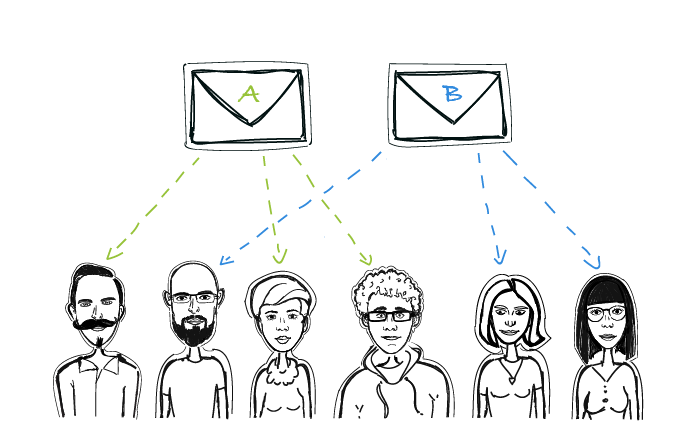Cold email campaigns have become an integral part of B2B SaaS marketing strategies. However, to ensure their effectiveness and maximise response rates, it is crucial to employ A/B testing. It allows businesses to experiment with different email variations, enabling them to optimise their messaging and drive better results. This article delves into the significance of this testing in cold email campaigns and how it can help businesses achieve their marketing goals.
8 Reasons Why A/B Testing Is Not To Be Ignored
Here are 8 great reasons why you should never undermine the importance of A/B tests.
Enhancing Subject Lines
Crafting compelling subject lines is essential to capture the attention of busy professionals. A/B testing helps marketers experiment with different subject lines, analysing open rates and click-through rates to determine the most effective approach. A B2B SaaS company tested subject lines like “Boost Your Productivity with AI” versus “Transform Your Workflows with AI”. It discovered that the latter resulted in a 20% increase in open rates, demonstrating the power of A/B testing in optimising subject lines.
Optimising Email Copy
The content of your cold email plays a pivotal role in driving engagement. A/B testing allows marketers to test different email copies to identify the most persuasive messaging. A B2B SaaS provider conducted an A/B test with two variations of an email—one emphasising cost savings and the other highlighting productivity gains. They found that the version focusing on productivity gains yielded a 15% higher response rate, showcasing the impact of A/B tests in refining email copy.
Personalisation and Segmentation
Personalisation and segmentation can significantly impact the success of cold email campaigns. A/B testing of different personalised elements, like recipient’s name or mentioning their company are highly crucial. That’s because it helps marketers gauge the effectiveness of personalisation in driving engagement. Furthermore, segmenting the audience and testing different email variations for each segment can help tailor the messaging to specific customer needs. This ultimately results in higher conversion rates.
Suppose a B2B SaaS company segmented their email list based on customer industry and tested tailored offers for each segment. In that case, they’ll observe a 30% increase in conversion rates, which explains why A/B testing in personalisation and segmentation.
Also read: The Future Of Social Selling And Trends To Watch Out For
Call-to-Action Testing
The call-to-action (CTA) in a cold email is the desired outcome, such as requesting a demo or scheduling a call. A/B tests allow marketers to experiment with different CTAs, testing variations in wording, placement, and design. By analysing the click-through rates and conversion rates associated with each variation, businesses can optimise their CTAs. This will elicit the desired response. Suppose we test two different CTAs—one focusing on “Schedule a Demo” and the other on “Request Pricing.” The “Request Pricing” CTA will generate a 25% higher conversion rate, clearly pointing to the importance of testing for refining CTAs.
Timing and Frequency
When it comes to cold email campaigns, timing and frequency are crucial factors. A/B tests can help determine the best time to send emails and how often they should be sent. Research suggests that sending emails in the morning on Tuesdays and Thursdays resulted in a 40% increase in open rates. This shows that testing helps in timing and frequency optimisation. These tidbits of information would also be inaccessible without A/B tests.
Design and Layout
The visual appeal and layout of a cold email can impact its effectiveness. A/B tests allow marketers to experiment with different designs, layouts, and formatting options to determine which resonate best with the target audience. Consider two email templates—one with a minimalist design and another with a more vibrant and colourful layout. The vibrant layout will generate a 30% higher click-through rate.
Testing Sender Names and Email Addresses
The sender’s name and email address can influence the open rates and trustworthiness of a cold email. By A/B testing different sender names and email addresses (personal email versus company domain), businesses can determine useful insights. The combinations leading to higher open rates and better overall campaign performance would be easy to identify. In an A/B test, it was found that using the company name as the sender resulted in a 25% increase in open rates.
Continuous Improvement
A/B testing is not a one-time exercise but an ongoing process of improvement. Marketers can optimise their cold email campaigns by consistently analysing the results and experimenting with new variations. This iterative approach ensures that businesses stay ahead of the competition and adapt to changing customer preferences and market dynamics. A B2B SaaS company should regularly conduct A/B tests on different elements of cold email campaigns. This practice will help create a steady improvement in its overall response rates over time.
Conclusion
In the unpredictable B2B SaaS landscape, A/B testing is an invaluable tool that empowers businesses to refine their cold email campaigns and achieve better outcomes. Marketers can use A/B tests to optimise subject lines, email copy, personalisation, CTAs, timing, design, and sender details. These tests ensure their cold emails are relevant, engaging, and resonate with their audience.
A/B tests provide data-driven insights that enable informed decision-making, iterative improvements, and a competitive edge in customer acquisition efforts. Embracing A/B tests as continuous refinement is essential for SaaS companies to maximise the impact of cold email campaigns.
Follow Zohort for more updates.


